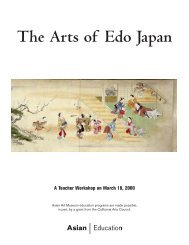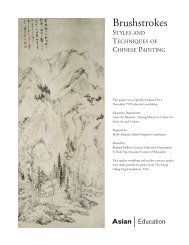Sacred Arts of Tibet (.pdf) - Asian Art Museum | Education
Sacred Arts of Tibet (.pdf) - Asian Art Museum | Education
Sacred Arts of Tibet (.pdf) - Asian Art Museum | Education
Create successful ePaper yourself
Turn your PDF publications into a flip-book with our unique Google optimized e-Paper software.
<strong>Sacred</strong> <strong><strong>Art</strong>s</strong> <strong>of</strong> <strong>Tibet</strong><br />
6) lamps made from oils <strong>of</strong> demons<br />
7) demon flesh to eat<br />
8) music, played on thigh-bone trumpets, damaru drums made from skulls, cymbals, and the ghanta<br />
What is Sino-<strong>Tibet</strong>an art?<br />
This thunderbolt and bell were cast for the Chinese Emperor Yong-le (1403-1424) as a gift for a distinguished<br />
lamas <strong>of</strong> <strong>Tibet</strong>. The Emperor possibly wished to gain merit for the commission. This and other<br />
gifts like it show the relationship between the <strong>Tibet</strong>an lamas and the Manchu Emperors <strong>of</strong> China (Ming<br />
dynasty). Known as the priest-patron relationship, this was one way that ideas and artistic styles spread<br />
between Manchu controlled China and <strong>Tibet</strong>. <strong>Art</strong>ists working in China in imperial workshops were<br />
ordered to make <strong>Tibet</strong>an style objects for either the personal use <strong>of</strong> the emperor or to send to important<br />
lamas in <strong>Tibet</strong>, who were <strong>of</strong>ten considered to be their spiritual teachers.<br />
Discussion Points/Teaching Suggestions<br />
1) Discuss the concept <strong>of</strong> origins, e.g. Sino-<strong>Tibet</strong>an<br />
Have you ever thought about the origins <strong>of</strong> hip hop music or blue jeans? What about where you came<br />
from. Do you or anyone you know identify themselves as Chinese-American or Irish-American or<br />
African-American? This bell and thunderbolt may have been made in China, but they are classified as<br />
<strong>Tibet</strong>an objects because the form, style, and use are <strong>Tibet</strong>an. <strong>Museum</strong>s usually classify objects by place,<br />
but object like this complicate matters. There is a comparable situation in Japan, where Korean-style<br />
ceramics were made by Korean potters in Japan for Japanese consumers. Which department do you think<br />
these objects belong to—their country <strong>of</strong> manufacture or the country that used them, or should they be<br />
hyphenated?<br />
Sources<br />
The <strong>Asian</strong> <strong>Art</strong> <strong>Museum</strong> <strong>of</strong> San Francisco, Selected Works, second printing (San Francisco: <strong>Asian</strong> <strong>Art</strong><br />
<strong>Museum</strong>, 1994): p. 42.<br />
Pratapaditya Pal, <strong>Tibet</strong> Tradition and Change. (New Mexico: The Albuquerque <strong>Museum</strong>, 1997): pp. 166-<br />
8.<br />
Dan Martin in Valrae Reynolds, From the <strong>Sacred</strong> Realm: Treasures <strong>of</strong> <strong>Tibet</strong>an <strong>Art</strong> from The Newark<br />
<strong>Museum</strong> (Munich, London, New York: Prestel Verlag, 1999): pp. 133-139.<br />
50<br />
<strong>Asian</strong> <strong>Art</strong> <strong>Museum</strong>
















